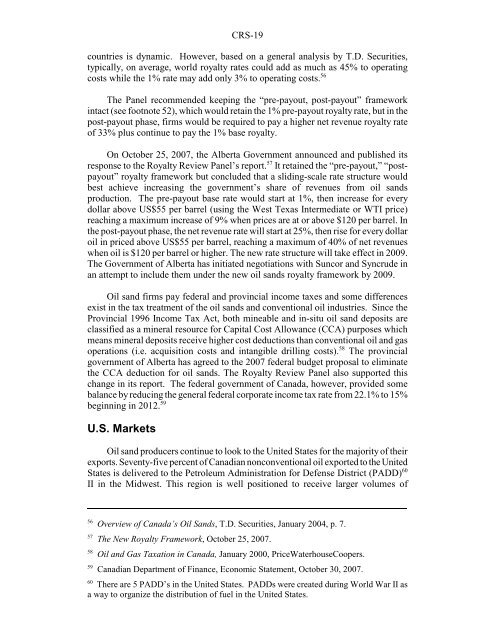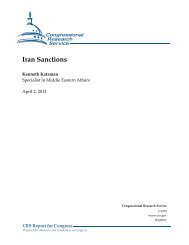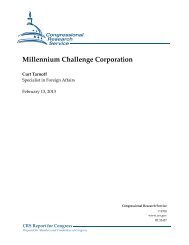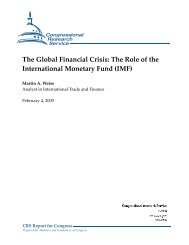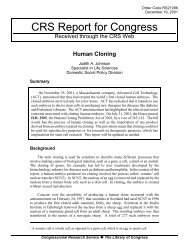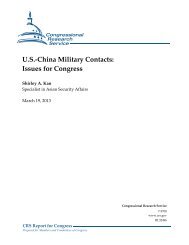North American Oil Sands: History of ... - The Air University
North American Oil Sands: History of ... - The Air University
North American Oil Sands: History of ... - The Air University
You also want an ePaper? Increase the reach of your titles
YUMPU automatically turns print PDFs into web optimized ePapers that Google loves.
CRS-19<br />
countries is dynamic. However, based on a general analysis by T.D. Securities,<br />
typically, on average, world royalty rates could add as much as 45% to operating<br />
costs while the 1% rate may add only 3% to operating costs. 56<br />
<strong>The</strong> Panel recommended keeping the “pre-payout, post-payout” framework<br />
intact (see footnote 52), which would retain the 1% pre-payout royalty rate, but in the<br />
post-payout phase, firms would be required to pay a higher net revenue royalty rate<br />
<strong>of</strong> 33% plus continue to pay the 1% base royalty.<br />
On October 25, 2007, the Alberta Government announced and published its<br />
response to the Royalty Review Panel’s report. 57 It retained the “pre-payout,” “postpayout”<br />
royalty framework but concluded that a sliding-scale rate structure would<br />
best achieve increasing the government’s share <strong>of</strong> revenues from oil sands<br />
production. <strong>The</strong> pre-payout base rate would start at 1%, then increase for every<br />
dollar above US$55 per barrel (using the West Texas Intermediate or WTI price)<br />
reaching a maximum increase <strong>of</strong> 9% when prices are at or above $120 per barrel. In<br />
the post-payout phase, the net revenue rate will start at 25%, then rise for every dollar<br />
oil in priced above US$55 per barrel, reaching a maximum <strong>of</strong> 40% <strong>of</strong> net revenues<br />
when oil is $120 per barrel or higher. <strong>The</strong> new rate structure will take effect in 2009.<br />
<strong>The</strong> Government <strong>of</strong> Alberta has initiated negotiations with Suncor and Syncrude in<br />
an attempt to include them under the new oil sands royalty framework by 2009.<br />
<strong>Oil</strong> sand firms pay federal and provincial income taxes and some differences<br />
exist in the tax treatment <strong>of</strong> the oil sands and conventional oil industries. Since the<br />
Provincial 1996 Income Tax Act, both mineable and in-situ oil sand deposits are<br />
classified as a mineral resource for Capital Cost Allowance (CCA) purposes which<br />
means mineral deposits receive higher cost deductions than conventional oil and gas<br />
operations (i.e. acquisition costs and intangible drilling costs). 58 <strong>The</strong> provincial<br />
government <strong>of</strong> Alberta has agreed to the 2007 federal budget proposal to eliminate<br />
the CCA deduction for oil sands. <strong>The</strong> Royalty Review Panel also supported this<br />
change in its report. <strong>The</strong> federal government <strong>of</strong> Canada, however, provided some<br />
balance by reducing the general federal corporate income tax rate from 22.1% to 15%<br />
beginning in 2012. 59<br />
U.S. Markets<br />
<strong>Oil</strong> sand producers continue to look to the United States for the majority <strong>of</strong> their<br />
exports. Seventy-five percent <strong>of</strong> Canadian nonconventional oil exported to the United<br />
States is delivered to the Petroleum Administration for Defense District (PADD) 60<br />
II in the Midwest. This region is well positioned to receive larger volumes <strong>of</strong><br />
56 Overview <strong>of</strong> Canada’s <strong>Oil</strong> <strong>Sands</strong>, T.D. Securities, January 2004, p. 7.<br />
57 <strong>The</strong> New Royalty Framework, October 25, 2007.<br />
58 <strong>Oil</strong> and Gas Taxation in Canada, January 2000, PriceWaterhouseCoopers.<br />
59 Canadian Department <strong>of</strong> Finance, Economic Statement, October 30, 2007.<br />
60 <strong>The</strong>re are 5 PADD’s in the United States. PADDs were created during World War II as<br />
a way to organize the distribution <strong>of</strong> fuel in the United States.


